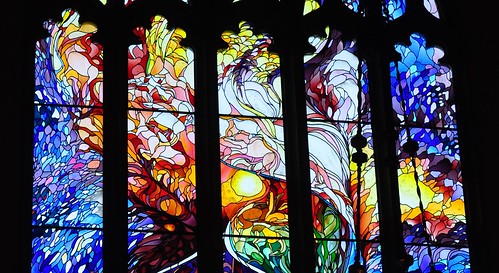Latest Posts
“What I want to know is, “ Mark asked pleadingly, “why has God forsaken us?”
Mark and his wife Diane, a homeless couple, has just been forced to move from the camp that they had peacefully dwelt in for years. They have nowhere to go. A summer storm blew through Portland the last couple days and because they had nowhere to legally set up their tent, they were soaked the other night, hiding for cover, and now they have no dry blankets or clothes.
They came into our church’s day shelter yesterday freezing. We were able to give them a warm meal and a change of clothes and some dry bedding… but Mark’s question lingered. He said, “I’ve been praying. I’ve been seeking God for help. Why won’t he help us?”
Honestly, I gave some pious answer about waiting and God’s timing isn’t our timing. But I wasn’t really being honest to him. I woke up at 6 this morning with his question haunting me. I couldn’t get any more sleep, so I want to be honest with you today:
The reason Mark isn’t being helped by God is because God has already given the power to help him to His people, the church, and the church isn’t interested. (more…)
SteveK
July 24, 2014
Uncategorized
Read more >
I am uncompromisingly pro-gay marriage and I am unapologetic in my affirmation of LGBT equality. This is one issue that I refuse to compromise on, and because of this, it has gotten me in trouble in the past. One church that it did get me in trouble with was my local Presbyterian Church USA congregation. The congregation and presbytery I was a part of were and are socially conservative, but I was a flaming liberal. Naturally, I found myself in some serious disagreement, and it didn’t help that I was a universalist, pacifist, and straight up commie-pinko. While the local Presbyterian community did not appear very welcoming, I am happy to see that the PCUSA has recently become fully LGBT-affirming at the national level.
Now that this has happened however, I am seeing the same old arguments from my conservative brethren that I have heard over and over again. It happens whenever any Christian denomination becomes welcoming and affirming, and I see the battle lines being drawn in the Mennonite Church as well. This is especially the case in Pittsburgh, because Pittsburgh Mennonite Church just became officially LGBT-affirming, and even lost their pastor because of it. I remember mentioning my uncompromising position on this issue to the local Mennonite conference minister as well, and I think I saw her cringe. If I remember correctly, she said that might be a problem at some point, but whatever.
The main argument that I see from conservatives on this issue is that gay marriage is somehow against the clear teaching of the Bible. Whenever we become open and affirming in our Christian faith, it is because we are ignoring the authority of the Bible. Guess what, I am not open and affirming in spite of the Bible, but because of it! (more…)
KevinD
June 20, 2014
Church, Current Events, Emerging Church, Interpretation, LGBTQ, Mennonite Church USA, Social justice, The BibleBible, Church, Evangelical Christianity, LGBT, Mennonite, Pink Menno, Politics, Progressive Christianity, Social justice
Read more >
Today a friend shared his experience when he was a young white teenager hanging out with young Latino men. When there was a possibility of encountering the police, they would say, “act white” and my friend would be asked to do the talking. What does “acting white” look like? If you’re asking that question, you’re probably white. For people of color in the United States there is often a “constant background processing” to empathize with white people around them and deal with their stereotypes. Strategies may range from dressing impeccably to whistling Vivaldi.
This week I’m preparing for a panel with Mennonerds on Race, Mutuality and Anabaptist Community. This blog post is a brief look at some of the themes I’m hoping we can discuss as practices for white people developing lenses to see differently through listening with humility.
Let’s start with changing lenses as Jesus talked about in this classic Sunday school passage, Matthew 18:1-5:
At that time the disciples came to Jesus and asked, “Who, then, is the greatest in the kingdom of heaven?” He called a little child to him, and placed the child among them. And he said: “Truly I tell you, unless you change and become like little children, you will never enter the kingdom of heaven. Therefore, whoever takes the lowly position of this child is the greatest in the kingdom of heaven. And whoever welcomes one such child in my name welcomes me.” (NIV)
Immediately in my mind’s eye I see this image or one of a thousand like it:

(more…)
TimN
June 11, 2014
Power, Privilege, Race
Read more >
The Third World is alive and well within North America. The poor are in the apartments with black mold; they are in the food stamp offices and being run out from under bridges. Difficulty and disease and shame mark their lives; they’re stigmatized like lepers. Jesus is among these people; living with them, encouraging them and doing miracles among them.
But you’d never know this by looking at the churches of North America.
A few churches cater to the upper class, but the massive majority of churches throughout North America see themselves as ministering to “communities”, by which they mean communities of the middle class. The poor are left out of the equation of the normal, everyday life of the church. And because of this, the church itself is poorer. Below are four areas in which the poor are marginalized in most modern churches:
1. Cultural uniqueness
The third world of North America is unique, and has unique features. For one thing, its inhabitants tend to use foul language, even the most religious of them. More poor people smoke than middle class people, and they are also more likely to have obvious addiction issues. Poor people tend to be less educated and focus more on survival. But, paradoxically, the poor are more likely to give their last dollar to someone else in need. Poor folks are more likely to rely on God instead of a system or even their own work. These are unique cultural characteristics, not right or wrong, just different. There are weaknesses and strengths in this culture, just as there are in the cultures of the middle or upper classes (or, indeed, in any culture).
The cultural uniqueness of being poor isn’t celebrated, but preached against in the everyday church. Not that every facet of poor culture should be celebrated; but the same is true of the middle and upper class cultures. When we praise the middle and upper class trait of making and following a reasonable budget, for example, why can we not also praise the lower class trait of sacrificial generosity? The church cannot be a culture-free environment, but in our middle-class model of church, where can the poor worship in a manner cohesive to their culture? (more…)
SteveK
May 27, 2014
Church, Class, poverty, Social justiceAdd new tag
Read more >
For the last week, I have been part of a delegation from Christian Peacemaker Teams (CPT) Europe to Greece to listen to the stories of refugees into Europe and those working with them here. Here are a few windows into our time so far.
Thursday morning our boat arrived to Lesbos. We rented a car and have been visiting people and places. From Lesbos, you can literally see Turkey on the other side of the straits.

The view across the water from Lesbos to Turkey

CPT delegate Kathryn and I on the boat from Athens
We drove up to the village of Kalloni (central Lesbos) to meet with Father Stratis, a Greek orthodox priest who has been helping refugees for 10 years. Refugees arrive to the village soaking wet and exhausted, often having walked many hours. Greek citizens face jail time if they pick up the migrants (similar to U.S. citizens at the border with Mexico). If they know their way it is 10 hours from the beach to Kalloni. If they don’t know the way, it may take days. George described how their shoes are usually completely destroyed between the water and the walking. The balcony of Father Stratis’s church is filled with donations of clothes that he and three volunteers sort and process for handing out.
(more…)
TimN
April 14, 2014
activism, Immigration
Read more >
This post is the final part of an essay looking at the Anabaptist movement through the lens of social movement theory. See Part III in the series here, which compares the early Anabaptist movement with four stages of social movements.

Photo by Rachel Friesen
Gaps, Tensions and Overlaps
Though there are apparent overlaps, it is clear by now that there are also gaps where the phases of social movements inadequately describe or leave out elements of the Anabaptist movement. Sociologist Charles Tilly writes, “The employment of invariant models…assumes a political world in which whole structures and sequences repeat themselves time after time in essentially the same form. That would be a convenient world for theorists, but it does not exist.”
One shortcoming of social movement theories is that they sometimes fail to capture the many complex, different stories within an observed movement. They tend to look at movements as a whole, and the four phases are very linear in their approach. While this progress-oriented “bird’s eye view” is often helpful, it misses the contradictions present on the ground. C. Arnold Snyder offers a more nuanced understanding in his way of describing the Anabaptist movement as a polygenesis rather than monogenesis. He highlights the similarities and differences in how Swiss, South German-Austrian, and North German-Dutch Anabaptisms developed, conversed and converged. The polygenesis approach does not lend well to the homogenizing categorization implicit in social movement theories. For example, one may argue that Anabaptism did in fact experience the fourth phase of decline due to eradication by the sword in Austria and many parts of South Germany, though in other places it survived. (more…)
KaterinaF
March 29, 2014
Anabaptism, History, Social movements
Read more >

by Jerrett Lyday
Is it not so, that from its conception, Christianity has always, to some degree, been wrapped up and consumed by Empire? There is a dark and ominous foreshadowing in the temptation of Christ, where Satan offers up the kingdoms of the world, in all their glory. We realize, of course, that we have submitted ourselves to the demonic, that now, in hindsight, Christ left the desert with a golden crown on his head, and descended upon his glorious, gilded throne, rather than dying there on the hill in golgotha.
Perhaps this is what Martin Scorsese really intends with his film, “The Last Temptation of Christ”, where Christ (Willem Dafoe) submits to the temptation to wield God’s power and remove himself from the cross. He goes on to live a normal life, marrying Mary Magdalene having children, etc. Perhaps Scorsese gets at a horrible reality of our Christian condition today, that our Christianity looks more and more like Christ submitted to Satan’s temptations, that he had given into the conditions sanctioned by the ruling elite, and surrendered into the bourgeoisie, leaving our world relatively unchanged and forever steeped in slavery. (more…)
JerrettL
March 28, 2014
Anabaptism, History
Read more >
This post is the third part of an essay looking at the early Anabaptist movement through the lens of social movement theory. See Part II in the series here, which looks at definitions of social movements.

Photo by Katerina Friesen, Sainte-Chapelle
The four generally recognized stages of a social movement are emergence, coalescence, bureaucratization, and decline.(1) Some social movements never evolve beyond the first two or three stages, and others continue in new forms if they are adapted into mainstream society. The model of four stages of social movements sheds light on elements of the Anabaptist movement, though it has limitations, since, as I have argued, the Anabaptist movement was not a social movement according to modern definitions.
Emergence
The first stage of social movements, emergence, is seen as the time when consciousness of a problem or societal ill is just forming. Collective action has not yet grown out of the discontent that is felt by many people, and organized leadership has not yet emerged though “agitators” may be at work at the grassroots. I believe that both the Peasants’ Revolt and the Protestant Reformation were crucial in this first stage of emergence.
The Peasants’ Revolt (1524-1525) laid the groundwork for widespread social unrest, and raised issues of unjust rulers and the need for social reform. Snyder writes that many early Anabaptists, especially in South German regions, were closely involved with the peasant movement for social reform and shared many of their egalitarian ideals. Hubmaier, for example, started his evangelical reform teachings in Waldshut, which greatly supported the peasants. Snyder also cites other early Anabaptist leaders’ connection or collaboration with the peasants; these leaders included Reublin, Brötli, Krüsi, Grüningen, Hut and Rinck. He writes, “Many of the same religious, social and economic impulses that fueled the so-called Peasants’ War remained issues within the Anabaptist movement well after the peasant uprising had been suppressed. Many of the first Anabaptists were active in these protest movements ‘from below.’”(2) (more…)
KaterinaF
March 27, 2014
Anabaptism, History, Social movements
Read more >
See part 1 in the series here.
Was the 16th century Anabaptist movement a social movement? There are many parallels between modern social movements and the Anabaptist movement; some writers actually use the term “social movement” to describe early Anabaptism. However, I argue that the Anabaptist movement was not a social movement by definition, though social movement theory can still provide a helpful lens with which to understand the Anabaptist movement of the 16th century. This paper examines the stages and elements of the Anabaptist movement using social movement theory as well as the textbook by C. Arnold Snyder, Anabaptist History and Theology. I conclude with reflections on the tensions and opportunities that interacting with social movements offers Anabaptism today, as well as the relationship between movement and mission.

Photo by Katerina Friesen
Defining Social Movements
It is important to begin with a definition of social movements and a brief survey of theories of social movements. One broadly sweeping definition is, “[Social movements] are voluntary collectivities that people support in order to effect changes in society.” The sociologists behind this definition, McCarthy and Zald, formulated a foundational way of looking at social movements for the discipline, the resource mobilization perspective, which was a response to theories that too-narrowly saw general mass discontent and ideology behind protest activities. The resource mobilization perspective moved away from analyzing the social psychology of the masses toward an emphasis on the resources, such as money, labor, costs and rewards, as well as non-material benefits that draw people into collective action and social movements. Today, some theorists believe that although they laid the groundwork for future theories, resource mobilization perspectives were too scientific and empirical. More recently, sociologists have examined the cultural and emotional elements that drive social movements. This newer, perhaps more inclusive, imagination of the forces behind social movements recognizes that emotions such as moral intuition or “the joy of imagining a new better society” are part of social movements, thus blurring the distinction between rational and emotional motivations for movements.
(more…)
KaterinaF
March 16, 2014
Anabaptism, Social movements
Read more >
This is the first in a four part series from my essay entitled, “The Early Anabaptist Movement through the Lens of Social Movement Theory.”
By way of introduction to my piece, I wrote the following poem. I invite you to read it as an exercise of imagining what the emerging Anabaptist movement must have felt like to a new believer.

Movement of the Word, 1525-1535
The word spreads on farms,
in taverns and barns, in sewing circles
the fold grows, stitch by stitch.
Behind the looms we whisper
good news and now dozens come to sit
on stumps and stone, our forest pews.
We dare not learn our leaders’ names,
for fear that tortured tongues might speak;
we know the brothers when they say,
“The Lord’s peace remain with thee.”
‘Til He returns to vanquish our foes,
many join Christ’s agony. (more…)
KaterinaF
March 15, 2014
Anabaptism, History, Martyrdom, Poetry, Politics, Social movements
Read more >
Recently, I started rereading Paul’s First Epistle to the Corinthians. It’s been a long time since I have read Paul, and the last time I really read him, IÂ spiritualized him. By that, I mean that I made Paul’s words the words of an Anglo-Saxon Puritan. Coming from a Protestant (Reformed) background, it is really easy to see Paul’s talk of election in the meaning Calvinists give to it, and it is easy to see Paul as some modern German theologian in the tradition of Martin Luther. I was easily able to look at the material, political, and societal implications of Jesus’ teachings, but Paul was harder for me, due to that connection with Reformed Protestantism.
Going into First Corinthians anew, I learned that Paul’s epistle was written to a very special community of believers. Corinth was a deeply Roman and deeply cosmopolitan city. It was really the entire Greco-Roman world present in one place. This means that the Corinthian church was diverse, and part of that diversity involved Paul having converted both rich and poor, elite and common. The division of rich and poor in the Corinthian church was one of the reasons Paul wrote the letter. For example, in 11:17-34 we see Paul rebuking those were were treating the poor unfairly in communion. A passage that is particularly important in discussion these class relationships is 1 Corinthians 1:26-2:5: (more…)
KevinD
March 14, 2014
Class, Economics, Education, Privilege, The Bible1 Corinthians, Class, Kingdom of God, poor, rich
Read more >
Good afternoon, allies and humans of the Mennonite Church. I (a human who is queer) have a quick note, a “call to action,” if you will.
First, some facts:
- I am a human with a human life partner and a human (step/bonus/partner’s) son. In addition, members of my family such as my mother, brother, sisters, and father are humans.
- I am not an elephant.
- I am not an issue.
- I am not a crucible time.
- I am not a dilemma, a burden, a conflict, a problem, a discussion, a question, a challenge, a threat, or any other non-living, non-breathing thing, noun, verb, adverb, what-have-you.
- I am not even “homosexuality.”
With that out of the way, I’m going to ask you all to do something for me. Please, when you are discussing [insert euphemism for me here, such as “LGBT issues,” “the elephant in the room,” or “the current dilemma in the church,”] remember that you are discussing me. You are discussing whether or not you would like me to be a full member in the Mennonite Church, whether you would mind if a Mennonite pastor joined my partner and I together for a lifetime, whether you would mind if God called me and the Mennonite Church licensed me to minister to the Mennonite Church. (more…)
JenniferY
March 10, 2014
Allyhood, Mennonite Church USA
Read more >
This week in my seventh post in my ongoing Anabaptist Camp Followers series, I interview Benjamin Corey. He is a retired US Air Force instructor turned Anabaptist speaker and writer. He blogs at Formely Fundie and is author of the upcoming book, Undiluted: Rediscovering the Radical Message of Jesus.
 Can you share about your first encounter with Anabaptist thought and practice?
Can you share about your first encounter with Anabaptist thought and practice?
I first encountered Anabaptism when I was studying church history at Gordon-Conwell Theological Seminary, but it was only in the context of their role in Church history— we didn’t get much into Anabaptist thought and certainly didn’t delve into the existence of Neo-Anabaptism, so at that time I had no idea how deeply I would connect with it.
As I continued to make my way through seminary I went through a massive paradigm shift as I realized that even though I had been a Christian for more than 20 years, Jesus himself was the missing aspect to my faith. Once I made this realization, I went through a reorientation of my faith not around Christian religion but simply around Jesus— a process that is the topic of my upcoming book, Undiluted: Rediscovering the Radical Message of Jesus. During this reorientation, my views on a host of issues changed— I embraced nonviolence, gender equality, rediscovered the need to live out faith in authentic community and a host of other new discoveries.
I had no idea what to call myself anymore- I felt like a misfit in Christianity because I knew I wanted to follow Jesus, but didn’t know where I fit in. One day I picked up the book Naked Anabaptist and started reading about the tenants of the Anabaptist Network and it was a lightbulb moment for my wife and I, because it articulated our new worldview in a way that felt like someone was inside our head. In that process, we realized that Anabaptist ins’t necessarily something you become but something you realize you already became. Being able to "label" who we were was incredibly freeing for us and helped us realize that we weren’t alone anymore.
What are some of the ways you’ve connected with the wider Anabaptist community that have helped you feel like you are not alone?
Once I realized that I had been an Anabaptist all along, I started to seek out others like me and stumbled upon MennoNerds and folks like my friend Kurt Willems. While an online community is often a poor substitute for real-life interpersonal community, the Anabaptist community online is pretty darn good. It’s the first "tribe" that I’ve ever had where I felt like I belonged and like I was accepted— flaws and all. I think what I love about it is that it is diverse enough to allow for a "big tent" feeling yet we all share several core values to our faith that keep us all linked together. It’s something I haven’t quite experienced before— there’s definitely a kinship factor with the Anabaptist community. Ironically, the only other place I’ve ever experienced this was during my ten years in the military.
(more…)
TimN
March 2, 2014
Anabaptist Camp Followers, neo-Anabaptism, US Military
Read more >
MENNONITE CHURCH USA CHURCHWIDE STATEMENT ON LGBTQ COMMUNITIES, DIVERSITY, POWER, OPPRESSION &Â PRIVILEGE*
Introduction
Mennonite Church USA has roots in seventeenth-century churches planted by what today we might call “radicals” and “social justice activists” from Europe. Our church continues to grow and be enlivened by people who join us from many countries, backgrounds, races, genders, sexual orientations, abilities, as well as other diversities and differences. As Christians, we believe we are called to welcome these seekers of church community in our congregations and communities, especially as our government fails to serve all but a privileged few, with harsh laws frequently punishing difference. Assumptions about identity make some people more vulnerable to political biases and discrimination than others. Our concerns about the status of peace and justice in this country and in this world relate to how people are treated based on race, nationality, ethnicity, gender, sexual orientation, class, ability status, citizen status, religious identity as well as other statuses.
We reject our country’s mistreatment of people, repent of our silence, and commit ourselves to act with and on behalf of all our community members regardless of any status. (more…)
JenniferY
February 17, 2014
activism, antiracism, Current Events, disabilities, Ethics, Exclusion, Faith, Gender, Group Identity, Immigration, Indigenous, Leadership, LGBTQ, Love, Mennonite Church USA, Nonviolence, Peace & Peacemaking, Power, Privilege, Race, Sex, Tactics, Violencebisexual, gay, Inclusion, lesbian, LGBTQ, MC USA, MC USA Executive Board, Mennonite, queer, Statement, transgender
Read more >
Cross-posted from As of Yet Untitled
The Mennonite Church USA executive board meetings in Harrisonburg wrapped up yesterday. It’s been an intense two weeks. On Feb. 4, the Mennonite Church USA (MC USA) website posted Ervin Stutzman’s response to the “Rule of Love” letter from 150 pastors calling for MC USA “make space for congregations and pastors who welcome and bless lesbian, gay, bisexual and transgender (LGBT) Jesus-followers.”
As one of those responsible for managing Pink Menno’s social media presence, I’ve watched over the last few days as the community has responded to Stutzman in anticipation of the MC USA Executive Board meetings next week. This post curates different voices and perspectives from those who participate in the Pink Menno community. This is not an official Pink Menno statement.
As the MC USA Executive Board met, I hope they considered these voices.
Shift in tone and wording
A number of people appreciated the shift in tone they saw in Stutzman’s letter. The most obvious was his use of the term “people on the LGBTQ spectrum” rather than “gays” or “same sex attraction.” His use of this term acknowledges the existence of transgendered people (the T in LGBTQ). “He is naming that there is a problem with how we relate,” says Cynthia Lapp. “He is naming the pain. Small steps and yet coming from Ervin it is an important shift.”
(more…)
TimN
February 16, 2014
LGBTQErvin Stutzman
Read more >









